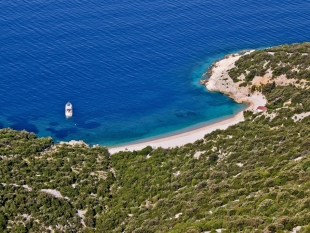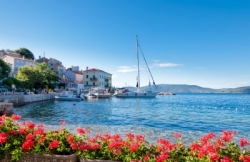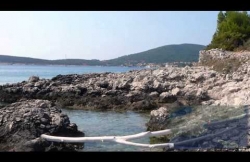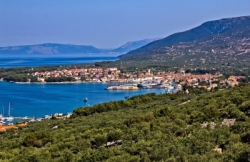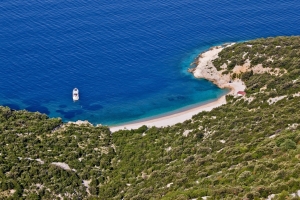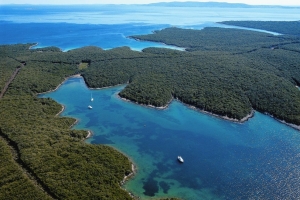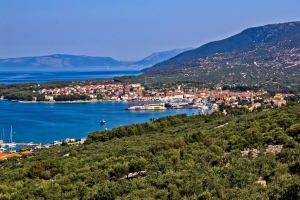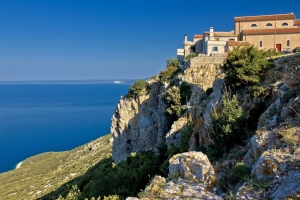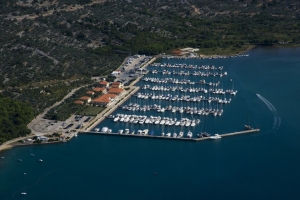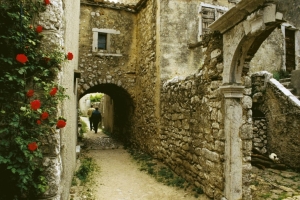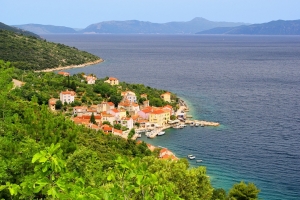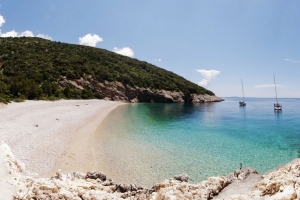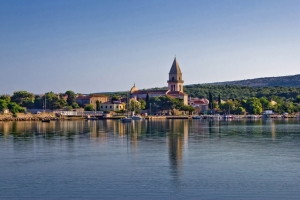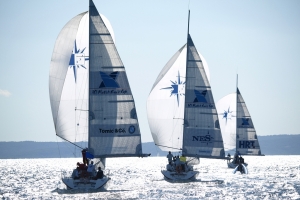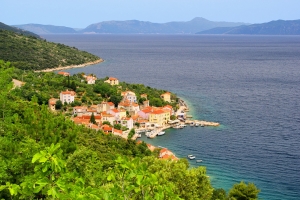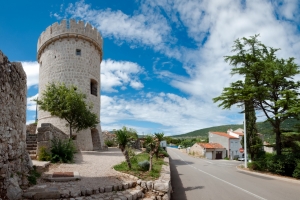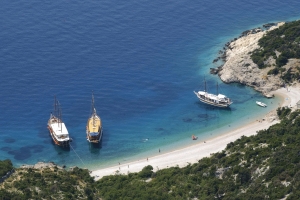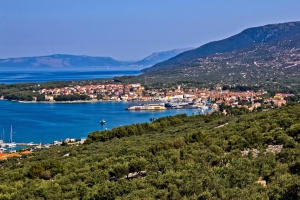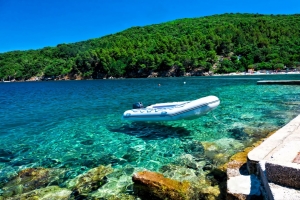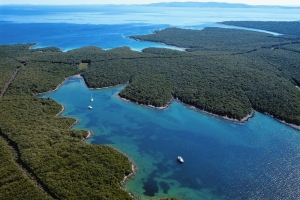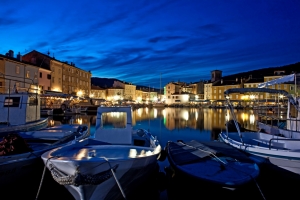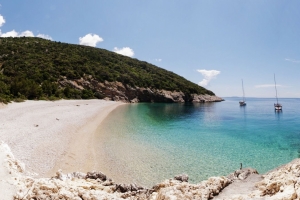The mountainous island of Cres is, following the nearby island of Krk, the second largest island in the Adriatic Sea. Cres stretches itself long and narrow in a southerly direction down and through the northern part of the Kvarner Bay. Typical of the landscape of the island are its picturesque, aspiring to heaven mountain ranges. The highest mountain, Gorica, reaches 648 meters above sea level. Due to the island's remarkable length, Cres has about 248 miles of coastline, where there are numerous idyllic pebbled beaches. The fine gravel and the gorgeous azure, warm water make the sea very inviting for a swim. A curiosity is the 5.75 square kilometer freshwater lake, which is used as a drinking water reservoir. Therefore, the banks of the reservoir should are only accessible by a few locals. The largest town is Cres City with about 2200 inhabitants .
The Purest Nature on Cres
Cres inspires its visitors with its enchanting natural landscapes. The north of the island is characterized by its dense forest and the middle part of the island is characterized by extensive vineyards and olive groves. In the south, the Mediterranean bushland covers the land with its barren pastures. Here you can see animals grazing, such as sheep and goats, whose milk is made into delicious cheese. This rustic, natural landscape is ideal for hiking. Hikers can expect to be amazed not only by the island's natural beauty, but also by numerous small churches just waiting to be discovered. With a little luck you can observe Cres's endemic and endangered Griffon Vulture. Cres has a very mild climate all year long which, although Mediterranean, has its continental echoes due to the mountains. Therefore, Cres experiences summers which are a little cooler than on the other Adriatic islands. The average temperature is around 24 ° C and is reaches its high mainly in the months of July and August. Winters are usually between a mild 7 ° C and 9 ° C. Cres offers the ideal conditions for a natural
The mountainous island of Cres is, following the nearby island of Krk, the second largest island in the Adriatic Sea. Cres stretches itself long and narrow in a southerly direction down and through the northern part of the Kvarner Bay. Typical of the landscape of the island are its picturesque, aspiring to heaven mountain ranges. The highest mountain, Gorica, reaches 648 meters above sea level. Due to the island's remarkable length, Cres has about 248 miles of coastline, where there are numerous idyllic pebbled beaches. The fine gravel and the gorgeous azure, warm water make the sea very inviting for a swim. A curiosity is the 5.75 square kilometer freshwater lake, which is used as a drinking water reservoir. Therefore, the banks of the reservoir should are only accessible by a few locals. The largest town is Cres City with about 2200 inhabitants .
The Purest Nature on Cres
Cres inspires its visitors with its enchanting natural landscapes. The north of the island is characterized by its dense forest and the middle part of the island is characterized by extensive vineyards and olive groves. In the south, the Mediterranean bushland covers the land with its barren pastures. Here you can see animals grazing, such as sheep and goats, whose milk is made into delicious cheese. This rustic, natural landscape is ideal for hiking. Hikers can expect to be amazed not only by the island's natural beauty, but also by numerous small churches just waiting to be discovered. With a little luck you can observe Cres's endemic and endangered Griffon Vulture. Cres has a very mild climate all year long which, although Mediterranean, has its continental echoes due to the mountains. Therefore, Cres experiences summers which are a little cooler than on the other Adriatic islands. The average temperature is around 24 ° C and is reaches its high mainly in the months of July and August. Winters are usually between a mild 7 ° C and 9 ° C. Cres offers the ideal conditions for a natural and relaxing holiday.
Routes to and from Cres
Cres is situated in the Kvarner bay before Rijeka. The best way for travelers to reach the island is by taking a ferry from Krk Island to Merag after Valbiska. From Istria one can enjoy the use of the ferry from Brestova to Porozina. The historic town of Cres finally can be reached via the main road No.100. Not to forget, the city itself is car free. Cres is also connected to the neighboring island of Losinj by a swing bridge near Osor.
Settlements on Cres
The car-free island of Cres's capital city is rich in architectural features. In principle, the entire town is a single museum. Visitors can, among other things visit various churches and monasteries, but also two city gates from the 16th century as well as an art museum. The city is built in the Venetian style. Other places of interest include the small spa town of Valun located at the southern end of the Bay of Cres- the location of the Austrian TV series "Facing the Sun"- or the original village of Lubenice. The village is located 378 meters above sea level and gives a wonderful view over the bay below. This bay is one of the most beautiful and most photographed beaches in Croatia. In the small town there are only 40 residents, but there are a total of six churches. One can readily recognize that there must have been a vibrant village community here in earlier times. Ideal for a more peaceful holiday are Miholascica Martinscici, which both stem from Roman times and which both have beautiful beaches.
How to get there
There are two peculiarities, in relation to the ferry services, that must be watched out for on Cres and the neighboring island of Losinj. Firstly, the two islands of Losinj and Cres are connected by a swing bridge, so when you travel by ferry and reach one island you automatically reach the other island. Secondly, it should be noted that various ferry routes start from various ports on Cres.
Cres has two major ferry routes with Jadrolinija ships: the car ferry between Merag (Cres) and Valbiska (Krk) and the car ferry between Porozina (Cres) and Brestova (Istria). The 25 minute fast connection to Krk is worthwhile, especially for those wanting to reach the Rijeka International Airport or wanting to go over the Krk bridge as quickly as possible to the mainland in the direction of Rijeka (city). The modern ferry service runs 12 times daily in the off-season and 13 times a day during high season. Those wishing to drive from Cres to Istria (or vice versa), can save themselves the bother of passing through Rijeka, and make the trip in 20 minutes directly by car ferry. In the off season, the boat runs 11 times a day, and in the high season 13 times a day. In addition, there is a passenger ferry from the Reederei Krilo ship company, which connects Cres and Mali Losinj with other islands such as Susak, as well as with the mainland once daily. The route leads from Mali Losinj on Ilovik, goes to Susak, Unije, Martinscici and Cres and then back to Rijeka. Directly to Zadar via Premuda, Silba, Olib and Ist, the car ferry service operated by Jadrolinija runs a route from Mali Losinj. This route number 401 runs Mondays and Fridays once a day. The trip takes about 6 hours and 45 minutes, and despite being quite a long journey-which goes by quickly- it provides the perfect opportunity to enjoy a mini-cruise along the mainland coast and to marvel at the unique beauty of the Croatian islands. By the way: Losinj is connected via the catamaran ship company of Venezia Lines in July and August with the Italian port city of Venice. Every Saturday a ship sets sail and reaches either Venice or Losinj after a 4 hour 45 minute crossing.
close








 Best of Croatia
Best of Croatia









